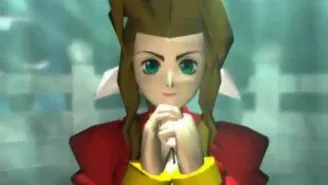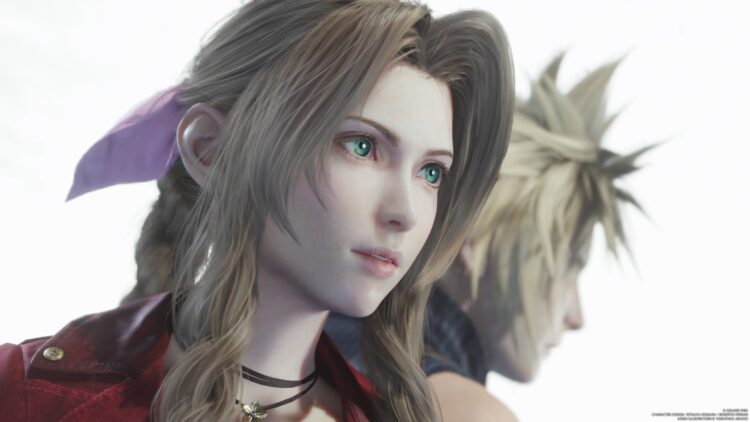As one of the most popular games of the 90s, Final Fantasy VII has had a wide reach outside of the gaming community. In 2019, it even cropped up in an episode of NPR’s This American Life. The popular slice-of-life radio show introduced the episode “Save the Girl” by discussing Final Fantasy VII. Namely, the character of Aerith Gainsborough and her role in the story. And the hosts found the beloved heroine… underwhelming, to say the least.
*Spoilers for Final Fantasy VII and Rebirth to follow*
For those not in the know, Aerith Gainsborough is a florist descended from a legendary race of planetary guardians, the Cetra. She also dies halfway through the original Final Fantasy VII. And, I suppose, halfway through newly released retelling Final Fantasy VII Rebirth (more on that later). The reason why NPR’s Lina Misitzis and Ira Glass bring up Aerith is to talk about the trope of damsels in distress. Their argument is that the “one-dimensional” Aerith solely exists to die. Her death motivates Cloud, the male hero of the game, to continue his quest and seek revenge. And that’s all.
Now, a few things. First, the trope of motivation stemming from a female character’s death is nothing new. In fact, it’s so widespread that it even has its own word for it, “fridging.” Writer Gail Simone coined the term in 1999, finding over 100 examples of the plot device in comics alone. The term notably derives from Green Lantern: A New Dawn. And the trope appears in everything from X-Men to multiple James Bond movies. It’s definitely been done to death, pun fully intended, and more recent stories can—and have—done better.

The Subtle Significance of Aerith Gainsborough
Yet, at the same time, I admit I bristled a little to hear Aerith’s death used as the poster child for this tired trope. It’s not so much that NPR is wrong. But the analysis is a tad reductive, like saying Hamlet is a play about daddy issues. While other examples exist primarily as this cliché (say, Ophelia from Hamlet), Aerith’s death has much more power behind it.
As this illuminating Tor article by K.W. Colyard explains, players lament this death because Aerith is an integral party member—the healer—and games at the time rarely if ever killed off a healer without replacing or reviving them. In terms of the story, she’s also the healer of the planet, and so her death resonates as it means her quest to save the world may have failed. But if you have only watched the game, or played until that point, it’s easy to see how her character arc could feel lackluster. So how to retell it in a way that paints Aerith as complex from the start?
Final Fantasy VII Rebirth, the remake of that section of the game, provides the answer. Now, the ending, which retells Aerith’s “death,” has proven divisive and ambiguous. I put “death” in quotes because it’s not clear if Aerith really dies, if she’s sent to a different timeline, or what. But while her fate is up in the air, her role in the story is not. In fact, it’s clarified more here than in the original game. How so?
Preparing Plans for the Planet
In the original, Sephiroth kills Aerith seemingly arbitrarily. Only at the end of the game do the characters—and the player—receive confirmation that in her last moments, Aerith sacrificed herself to cast a spell that could protect the planet. At this point, her death gets its greater meaning. But until then, it can feel like a simple plot device, as Cloud vows revenge.
But in Rebirth, Aerith clearly has a plan from the start. Using timey-wimey techniques that I won’t unpack here, she has one version of herself in a different reality safeguard her world-saving Materia to give to Cloud at the right moment. Meanwhile, she prays to save the planet, with Sephiroth going to kill her, like in the original. He seemingly succeeds, but thanks to her new powers of time and space, she returns to fight him off. Here, the haughty Sephiroth utters something never said before, “I underestimated you.”

In Rebirth, the Planet Strikes Back And Aerith Leads the Charge
A convoluted ending? In terms of plot, absolutely. And yet, with Sephiroth’s line and everything leading up to it, Final Fantasy VII Rebirth does clarify one thing. The retelling stresses that Aerith is not a poor girl senselessly slain, but a powerful figure who makes a calculated sacrifice to save the world. She goes toe-to-toe with Sephiroth and shows that he’s not the only one with grand machinations in place. She’s less Gwen Stacy and more Obi-Wan Kenobi; strike her down and she’ll become more powerful than you can possibly imagine. It’s all part of her plan.
The original game posits its primary conflict between Cloud and Sephiroth, two complex characters reckoning with their pasts and grappling to realize visions for the future. That’s still true here, but Rebirth contextualizes this a bit more within the war between Jenova, the world-destroying alien, and the planet itself. Aerith gets a greater role as the defender of the planet, just as Sephiroth fights for Jenova. This grants Aerith more agency while raising the stakes going into Part 3. We see Sephiroth command new forces, the dark whispers, with Aerith rallying light ones of her own in a battle across multiple timelines. Sure, her fate is (potentially) the same, and Cloud still seeks to stop Sephiroth. But if he’s fighting the battles, she’s fighting the war.
So for folks who found the ending confusing, I do sympathize. And for those who want to know if Aerith lives or dies, I await the answer too. However, if you think Aerith Gainsborough got tossed in the fridge? This time around, you’ve underestimated her.


